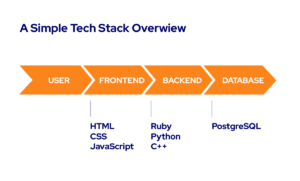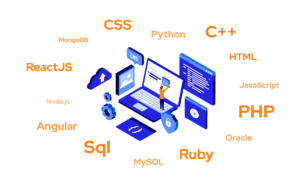
The art of choosing the right technological stack for a web and mobile application
With the current dynamics of technological development and business requirements, choosing the right technologies to lay the foundation for a well-functioning product is very important.
5 min read
In this Article:
- Why is it important to choose the right technology?
- What factors do we need to consider when developing a mobile application?
- Is selecting the Right Technology influence your Business?
Although the group of stacks is limited, the variations, proportions, and correct choice of tools are crucial to delivering a functional and safe end product to the customer.
What is a technology stack?
A technology stack, in practice, is a group of solutions, the combination of technology services, architectures, and languages that build an ecosystem of an application or website. It’s called a “stack” because one technology layer can be considered superimposed on another. It consists of two components: the back-end (how it works) and the front-end (what it looks like). In each part of the technology stack, you may see different formatting: front-end/back-end. So much for the theory.

It all starts with a problem that we are trying to solve, then an idea for a solution, and then we make it more concrete, giving it a shape of an actual application. Once we have an application in mind – how we want users to interact with it, and what it should do – we fit the tech stack to the application’s requirements. that keeps all the work under control and provides the right workflow.
With technological progress, the definition of the stack has been modified. It now carries many more elements due to the increased number of devices from which users can access and the huge number of events and data processing. It can include tools for containerization, performance monitoring, business analytics, event processing, cloud services, and so on. The list is quite long.
From this “mix”, it is possible to build a product tailored and customized for a business model, needs, and customer demand.

Of course, you will find :
- User interface (HTML, CSS and Bootstrap)
- Programming language (JavaScript, TypeScript, Python, Ruby, Scala,Kotlin)
- Execution environment (Java Runtime Environment (JRE), Node.js and Common Language Runtime (CLR))
- Databases (MongoDB and MySQL)
- Internet frameworks (Express, Spring, Django, Laravel)
Of course, another categorization can also be used for front-end or back-end views, or to distinguish solutions used for websites from those dedicated to mobile applications. It is worth remembering, however, that no matter what classification you use, the key is to create the right stack for the right project.
What drives the choice of the technology stack?
The first and foremost point of consideration when choosing a technology is:
- Goals: Does it support what we want to achieve?
- Compliance: A project might need to adhere to local laws, like GDPR, which might steer the choice of technology
- Team experience: choosing a complex technology in which no member of the team has the expertise, bears risks of low velocity of the group, missing its roadmap targets, and in general, being slow to respond to the market’s needs
- Technology support: choosing a technology with low technical support is risky. Suppose the team stumbles upon an issue, in the worst case. In that case, people will have to deal with it individually, contrary to technology with reasonable technical support, like a fully managed, cloud-provided service.
The right stack is a win-win for both sides.
As a partner with technological experience in the stack development process, a professional development team will consider each of the factors mentioned above. Any well-prepared collaboration will start with an in-depth conversation. It will be filled with questions:
- Who are your target users?
- What “problem” is the product trying to solve?
- If the product includes eCommerce, does it integrate with other channels? And many more…
Since we have a whole bunch of frameworks, libraries, and tools on the market, it’s worth trusting teams with years of experience. Such teams will select tailor-made solutions so that, as a client, we get a ready-made solution in the shortest time, not exceeding the budget and, most importantly, safe for the user.




